WATZIT?!
Model Engines of Unknown Origin
Page 4
Last update: September, 2007.
Click on images to view them in larger size and more detail.
Hover the mouse of double-underlined text to reveal the answers.
CI4S
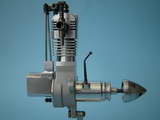 |
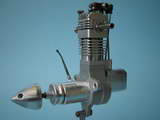 |
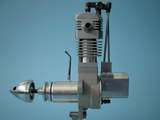 |
This watzit is a compression ignition four-stroke with an eccentric bearing on the crankshaft providing a degree of compression variation. There is also something strangely familiar about the crankcase. Give up?
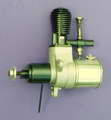 Don't feel bad if you could not instantly provide provenance. According to noted Czech engine expert Jiri Linka, no more than five examples were made by his fellow countryman, Mr. Poledn�k. Now as to why it might look a bit familiar. The engine at the right here is a reproduction of an early German Kratmo diesel. The crankcase of our four-stroke is the same casting, except that the bypass bulge has been machined away. While the top end of the engine is new, the compression adjustment are the same, as is the builder. Thanks to Bob Allen for the CI4S photos and Brian Cox for the Kratmo Repro association.
Don't feel bad if you could not instantly provide provenance. According to noted Czech engine expert Jiri Linka, no more than five examples were made by his fellow countryman, Mr. Poledn�k. Now as to why it might look a bit familiar. The engine at the right here is a reproduction of an early German Kratmo diesel. The crankcase of our four-stroke is the same casting, except that the bypass bulge has been machined away. While the top end of the engine is new, the compression adjustment are the same, as is the builder. Thanks to Bob Allen for the CI4S photos and Brian Cox for the Kratmo Repro association.
Sydney Sparkie
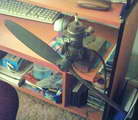 We have no idea what this is. As you can see by comparison of the hand-carved prop and the computer keyboard in the background, this is a rather large spark ignition engine. It is currently living in Sydney, Australia, and probably originated there. I've only seen the photos below, so what follows is merely what can be guessed from them.
We have no idea what this is. As you can see by comparison of the hand-carved prop and the computer keyboard in the background, this is a rather large spark ignition engine. It is currently living in Sydney, Australia, and probably originated there. I've only seen the photos below, so what follows is merely what can be guessed from them.
 |
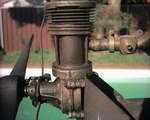 |
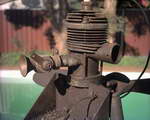 |
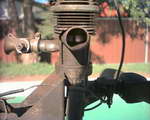 |
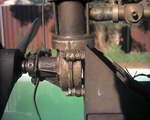 |
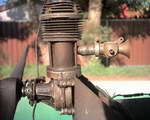 |
First, despite the rather Westbury Atom Minor-like head and exhaust, it's no Westbury design; ETW did not like long studs for holding head and cylinder to the crankcase. The timer is also too simple for Westbury, being rather Brown-like. Next notice the difference in patina between the rather modern looking throttle and the rest of the engine. I rather suspect that it is a later modification, though still not exactly recent. Finally, the castings: it's hard to tell under all the grunge, but they appear nicely made. They may not even be sand cast, though it's hard to tell. Except for the modern throttle, the design in general is very 1930's, as is the size. That was a period when the skill of home-grown casting was not as unusual as it is today, so it is possible that we are looking at a one-off, home-built. If anyone recognizes it, we sure like to know.
Rare and Beware
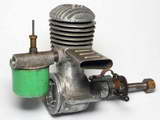 |
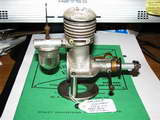 |
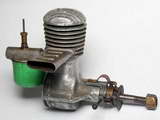 |
This is an easy one to identify from the bypass side (where the name is cast in), but it's sufficiently rare that the exhaust side view may have you scratching your head and reaching for Clanford's A-Z. Ok, no point in holding out any longer, it's a Drome Demon and rare as the proverbial pile of rocking horse droppings which I believe I stood in recently.
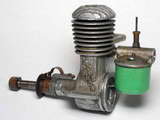 |
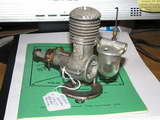 |
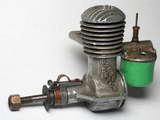 |
The engine is an English-made, pre-WWII, 6cc sparkie that fits in the "slag" category in that it featured—if that's the word—a pressed steel piston running (briefly) in an aluminium bore. The Drome part of the name derives from the maker, Model Aerodrome of 141 Stratford Road, Birmingham, England. The engine with the green tank is close to original, but there are variations that can also claim to be original as the engine was sold ready to run, and as a kit which is the "Beware" part of the cryptic title: the engine you buy may be a kit with all sorts of non-factory changes. OFW Fisher's book has a paragraph stating that there were two versions: the liner-less Mk I and a Mk II with a steel liner. Fisher is usually reliable, but as we can find no corroborating evidence, it could be that Fisher saw a home-made version that had been thoughtfully made with a liner. Another example has been seen that has no liner, but does have a cast-iron ring!
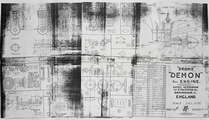 |
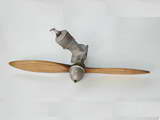 |
This original, almost readable and sadly un-dated plan from Ken Croft's extensive archive shows another unusual feature. Not only was the piston pressed from shim, so was the spinner and starting pulley! The plan shows the starting pulley secured under the conventional crankshaft nut, with the spinner balanced edge to edge and held in place with a long screw threaded into the end of the shaft. It would be easy to dismiss this as artistic license were it not for the photo of another example sent in by the reader that initiated this item. He recalls the engine being bought in Birmingham by his father and run but never flown, thus attesting to its originality. Visible in the photo is a screw right in the middle of the seemingly solid spinner! Note also the way the head screws into the case resulting in cooling fins being oriented at the mercy of the thread start and gasket thickness.
The tank and venturi on the example pictured in Clanford's A-Z are incorrect. While the caption gets the maker right, it claims a manufacture date of 1941. The engine picture may even have been made then, but if so, certainly not by Aerodrome as commercial model engine making and model engined petrol flying were banned in the UK at that time due to the war. Then again, while a valued resource, no one has recently accused the A-Z of being accurate.
 Also wrong is the tank and possibly the tanktop in this example taken from the auction catalog for Peter Fisher's collection. No photograph of a Demon appears in his book, but it is possible that this was the engine that convinced him that a second model with a steel liner existed. The paragraph in the book describing the engine makes mention of a contemporary reproduction Drome Demon made especially for collectors. If so, these are even more rare than the originals as none of the authorities in our group have ever heard of one, let alone see one! If any reader has such a beast, we'd welcome a photograph.
Also wrong is the tank and possibly the tanktop in this example taken from the auction catalog for Peter Fisher's collection. No photograph of a Demon appears in his book, but it is possible that this was the engine that convinced him that a second model with a steel liner existed. The paragraph in the book describing the engine makes mention of a contemporary reproduction Drome Demon made especially for collectors. If so, these are even more rare than the originals as none of the authorities in our group have ever heard of one, let alone see one! If any reader has such a beast, we'd welcome a photograph.
 The last piece to add to the puzzle is the only known advertisement for the Drome Demon to appear in the Aero Modeller. Now leaving aside the rather ambitious claim of the Demon being "The Greatest Scientific Achievement of the Century", note the date: February 1946. It could be that this ad was placed to test the water and see if they should revive an engine that they'd made years ago, or it just could indicate the introduction of the engine. Saying that the "Drome Demon Has Arrived" certainly suggests a product launch. If so, both Clanford and Fisher have the date rather badly wrong. It is really too bad that no date appears on Ken's plan.
The last piece to add to the puzzle is the only known advertisement for the Drome Demon to appear in the Aero Modeller. Now leaving aside the rather ambitious claim of the Demon being "The Greatest Scientific Achievement of the Century", note the date: February 1946. It could be that this ad was placed to test the water and see if they should revive an engine that they'd made years ago, or it just could indicate the introduction of the engine. Saying that the "Drome Demon Has Arrived" certainly suggests a product launch. If so, both Clanford and Fisher have the date rather badly wrong. It is really too bad that no date appears on Ken's plan.
Vintage Glow Engine
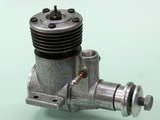 |
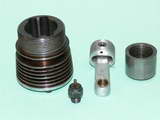 |
The descriptions used by sellers of model engines in eBay placements are really starting to get on my goat. If it wasn't made last Monday, they always call it vintage! *Sigh* There's nothing I can do about that except get upset and who wins then? The engine above was advertised simply as a "Vintage Glow Engine". Dave Owen bid on it and got it for a song; postage cost a dance, but that's another story. When it arrived, the story got interesting:
The steel, screw-in cylinder has a very thick lower section, which has four drilled, internal transfer flutes. These are flanked by twin exhaust slits, similar to a Cox engine. The piston itself is a fairly heavy cast iron slipper, threaded for an aluminium carrier which encloses the wrist-pin.
Most working parts are numbered, though no numbers match. The glow-plug fitted is an unknown and probably early design, being screwed rather than pressed together. While I was puzzling over all this, it did occur to me that the engine might be an early Czech design, possibly from Busek. So I looked it up in Jiri Linka's "Czech Model Engines" and found it on p90.
20mm bore, 14mm stroke,
weight 265g
I emailed Jiri asking for more details and he said the engine was rare, with only 3 known. Made by a Mr. Prevratil in Prague, there were approx 20 x 5cc and 10 x 10cc engines built. Dates not known, but my guess would be in the '50s.
The book Dave mentions is still available from Jiri for about US$25 plus postage. If Dave's guess about the manufacture date is right, it could almost qualify as vintage too. Don't start me...
A Mills-ish Watzit
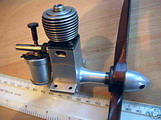 The eBay "Mills" |
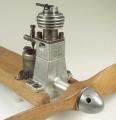 Swiss DYNO 1 |
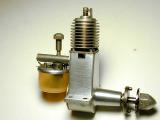 Genuine Mills 1.3 Series 1 |
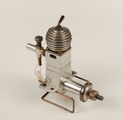 |
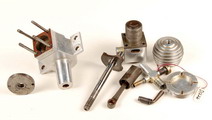 |
I just love to muddy the water a little bit, but the two pics show a strange little Mills-type thing that I have and dern if the crankcase does not look a lot like the one on Ebay, at least the lower part of the crankcase. Just for fun, here are some of the details:
| Bore: | 9.75mm |
| Stroke: | 16mm |
| Displacement: | 1.194cc |
Shaft diameter is 5mm and the crankpin is 4mm. The shaft is hardened and precision ground with a beautiful finish. Same taper as Mills Prop thread is 3/16x24TPI, which makes it a Whitworth thread. The prop drive washer is a Mills Mk1 part. The comp screw is 3/16X32TPI, probably a BS fine form The cylinder threads for the head are 13mmX26TPI, probably BS fine, same as the Mills 1.3 and the heads are interchangeable The backplate thread is the same as the Mills 1.3
Now for the mystery: Notice the engine has a very long trunk piston, and a "raiser block" was installed to compensate for that and the longer steel, bronze-bushed rod. This gives the engine an overall higher deck than the Mills production 1.3 engines, but the height difference is exactly the same as the riser block so the deck was originally the same on both engines. Notice too that the head is similar in design to the Ebay engine's head. I am forced to wonder if this engine is simply a development prototype that was used to see if there was any advantage to be gained from a longer trunk piston. The hold-down rods are exactly the same spacing as the production 1.3's. The entire case is nicely machined from the solid and the lugs are the same thickness as the lugs on my two MK1 engines.
[Unlike the Mills...] The transfer port is a single slot of generous dimensions, and the inlet port is a single big hole about the same size as the inlet tubing bore. The upper front edge of the piston is machined off at an angle to help "aim" the incoming charge up at an angle into the cylinder. All very neatly done. The wrist pin is pressed into the piston to prevent fouling the ports.
This does muddy the waters rather nicely, eh? Also, this engine has been run quite a lot and the piston shows sufficient wear to consider it run out.
Bert
The "long-trunk piston" Bert mentions stems from a theory held by Lawerence Sparey and DJ "Dickie" Laidlaw-Dickson circa 1946. They reasoned that if the piston of a diesel was made long in comparison to the bore, there would be less chance of compression loss as the "path" would be longer. This is just not so, but does serve to anchor such things in time and place.
Tiny Homebuilt Diesel
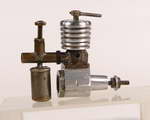 |
 |
This one came from Motor Boy, Bert Streigler, who says:
This little pitiful thing has been in some stuff that George Aldrich gave to me a long time ago. It is relatively crudely made and has all the characteristics of an engine built by a retired watchmaker who had never ever tired anything like this before. The little engine is only .098cc, or roughly .006 cubic inches, just over half the displacement of a Cox .010! It has a 5mm bore and stroke, The little shaft is 2mm and the crank pin is only 1.5mm. Now comes the horrible part. The backplate is threaded with a pitch of 1.5mm, which resulted in only 1 1/4 threads - looks more like a corkscrew than a thread. The cylinder is also roughly threaded, probably with a die, and has a pitch of 1mm.
The inside of the screw-on cylinder muff was threaded with a bottoming tap and is misaligned, The tiny piston has a 1mm brass wrist pin. The shaft, by the way, is an assembled thing with the drive disk being swedged on with a clockmakers tool that upsets a "ring" of metal against the shaft - sort of a hollow punch. The crankpin is swedged into a blind hole in the crankweb in the same manner. The tank is a small jewelers oiler container, but the "needle valve" is not a needle, not a pin, but a simple bolt with a 45 degree cone on one end that seats into a fuel tube roughly the same diameter as the air inlet tube.
You can be sure this engine never ran, but I have to admire the work that went into the really tiny cylinder assembly with it's soldered on inlet fitting and bypass cover. The crankcase appears to have been partially turned and then simply filed to shape by someone who really knew how to use a file. The prop drive is simply two nuts and a washer, possibly because they intended to use a sheet metal prop likt the ones with the Bambi or our Infant engines. I cleaned up the fins where someone had used pliers on them, but other that that and a general cleaning, this is the shape it was in as received. Only a curiousity, but an interesting one. I wish I knew who made it and when. It looks like a Sparey egg or something!
Bert
Eldon Who?
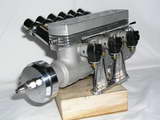 |
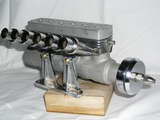 |
Readers of the Model Engineer may recall this engine from Malcolm Stride's account of the 74th Model Engineering Exhibition that appeared in issue #4248 of 27 May-9 June, 2005. From the name embossed in the case we can assume it is an Eldon. It appears to be an in-line, six cylinder two-stroke. The water cooled head and flywheel argue for a nautical application and the location of the Perry carbs argues for side port induction (imagine three Taplins joined end to end), although shaft rotary is also possible. The displacement of each cylinder is 10cc.
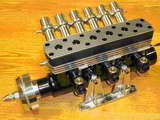 When this item was first posted, we asked that if some reader happened to know more about the provenance of this well made—and presumably very noisy—engine, Model Engine News and Malcolm would like to hear it. The Answer was kindly provided by Paul Knapp, founder of the Model Engineering Museum, where you can see another example of this stunning engine on display.
When this item was first posted, we asked that if some reader happened to know more about the provenance of this well made—and presumably very noisy—engine, Model Engine News and Malcolm would like to hear it. The Answer was kindly provided by Paul Knapp, founder of the Model Engineering Museum, where you can see another example of this stunning engine on display.
Whozit?!
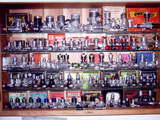 |
This picture, presumably of a collection in England, was sent in by Motor Boy, Ken Croft, and I'll let Ken explain why we call it a Whozit. Ken:
Recently I was indulging in the normally fruitless but non-the-less regular pastime of wandering about my local branch of PC World, the computer shop, looking for bargains. The vain hope is that they may have a sale in which their ridiculously high prices might have been reduced to near normal levels. Fat chance. Whilst I was flipping over some sample prints from the latest Canon printer, have a look at the attached print and see what I found. A rather nice A4 print on expensive Canon paper, of a rather nice engine collection. I immediately asked where the print image came from, and one obliging Asian assistant went asking questions all over the store, since he thought that it came from one of the security guards. He also opined that it may be a Canon stock image used for printer demonstrations. He search was fruitless. I offered to buy the print for the price of the paper, but I was quietly smiled upon and advised just to take the print. I did so, explaining at the cash desk that it was a gift.
The collection is of merit not because of the rarity of the engines, as most are easily found at UK swap meets. What lifts this collection from the norm is the apparent condition of the engines, and the fact that a number of original boxes are included. I thought I knew my local collectors, but this collection rings no bells. Just for completion, the back of the print says that the picture was taken on a Canon Ixus 50 (5Mpix), and printed on a Canon IP6600D printer.
I'd say Key did get a bargain, of sorts, from PC World after all. If any reader can tell us who the collection owner might be, we'd appreciate it.
Vintage British Home-built
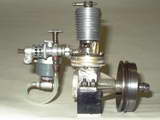 |
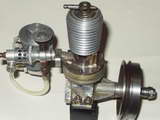 |
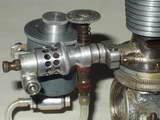 |
These pictures were sent in by Richard Jackson of Dorset, England. The engine is an obvious home-built with some vaguely familiar aspects to it. First, here is what Richard had to say about it:
I thought you might be interested in this old side port diesel I have just acquired. It is 3/4 inch bore so I guess about 6cc. It is about 5 inches high and looks like it was made for marine use as it has a 2 1/2 inch diameter heavy flywheel. The most interesting part is the induction and fuel tank arrangements, the inlet pipe on the motor is a copper pipe with a fine thread for the venturi to screw into which might be ok for a simple venturi but all the ironmongery hung on this one is asking a lot of it. The needle valve is nicely indexed from 1 - 10 as is the compression screw. The fuel tank is hung on the end of the venturi and includes no less than 3 gauze filters in its interior plumbing! There are 7 fibre washers in its construction. There is a neat screw operated choke arrangement on the extremity and the colander inlet includes another gauze filter.
The builder was fond of his straight knurling tool as he has used it most freely. The castings of the crankcase and fins are poor with blow holes and I think the flange may have parted company from the crankcase at some time as it appears to have been welded back on at an angle yet the engine turns quite freely.
The cylinder is brazed up construction and has a brass insert at the top of the bore with the contra piston working in this. I don't think it will run as it is low on compression and leaks around the cylinder flange. As it is an obvious one off home build I doubt anyone will recognize it but is it worth adding to your watzits?
No doubt about it being worth adding, Richard, and while I doubt we'll ever identify the builder, there are a few things worth noting. My guess is it is modelled on the Sparey 5cc, and there appears to be an ETW influence to the tank and carby. Unusual features are the mix of fasteners on the cylinder base, and the way the backplate seems to screw into the case with what looks like a knurled lock ring, providing an adjustable case volume--perhaps not intentionally. Some of the work is, to be kind, a bit crude. But the numbers stamped on the needle valve knob and around the comp screw are quite nicely done, as are parts of the carby assembly. And there appear to be two substantial spacers between case and cylinder flange, indicating earnest attempts at something! So, not attractive, but most unusual.
The Buck Rogers Comp Screw
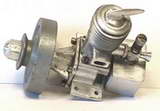 Photos of this engine were provided by Frank and Vicki Anderson who produce the Anderson Blue Book. Frank hoped this rather distinctive engine would be well known by collectors of obscure foreign diesels, but this is not the case. The crankcase castings are very, very similar to that used by ED on the Mk II and Competition Special, right down to the "front porch" at the top of the front bearing casting and the mounting lug "veranda" at the rear. But there is a slight difference around the screw bosses in the main casting and the rest of the engine is delightfully unique.
Photos of this engine were provided by Frank and Vicki Anderson who produce the Anderson Blue Book. Frank hoped this rather distinctive engine would be well known by collectors of obscure foreign diesels, but this is not the case. The crankcase castings are very, very similar to that used by ED on the Mk II and Competition Special, right down to the "front porch" at the top of the front bearing casting and the mounting lug "veranda" at the rear. But there is a slight difference around the screw bosses in the main casting and the rest of the engine is delightfully unique.
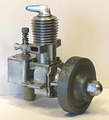 |
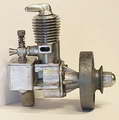 |
 |
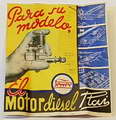 |
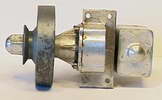 |
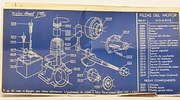 |
||
The lettering on the leaflet is a bit of a give-away to those who recognize Spanish when they see it. The most outstanding feature of the engine is the compression screw that reminds me of the fins on a Buck Rogers rocket ship. This heroic cast handle may make it easy to turn--until it heats up--and it could be a vulnerable item in a prang.
A curious aspect of the engine is the flywheel with the mandatory starting rope pulley, held on by the streamlined hex nut. What's wrong with this picture? There's no way to harness the mighty power output of this combination! The exploded diagram shows a prop driver as well. Perhaps the flywheel was for running in only.
From the bottom of the parts list, it looks like there may have been a patent involved. Sure would be interesting to know what it covered. We do know the "what and when" but not who made it, or how popular it may have been. If any reader can supply more history of the engine and its maker, please email us through the address at the bottom of this page.
Update: August 2006: Just a month after the Spanish Watzit appeared, Model Engine News received an email providing all the information we could wish for regarding this engine from Rafael Rodr�guez. Hover here to read what Rafael was able to tell us about the engine, and Click here to see the extra material he provided.
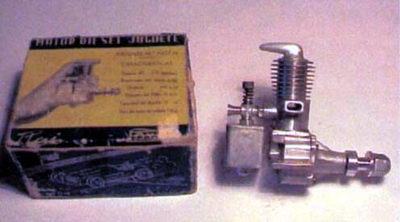
Tim Dannels of ECJ recognizes it as a Paya, 2cc capacity, made in Spain in 1947. From this photo provided by Tim, at least two would seem to exist!
Best regards. Rafael.
A 40 Year Norwegian Mystery
These photos came from Per A. Aasvestad of Rakkestad, Norway. They show an engine that has been in the possession of a friend of his for more than 40 years (as of 2006), but has been a mystery for all that time.
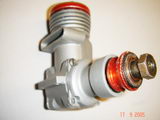
|
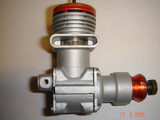
|
There are no apparent manufacturer's marks on it and I'll admit that it had me stumped, although I felt it had a certain Eastern European look to it. But Motor Boys Eric Offen and David Owen quickly identified it. I'll give you a clue: Like its brother diesels, it was cheap, and widely available for a short time in the 1950's. But they were not very good, so relatively few survive to this day. Give up? Hover here for the answer.